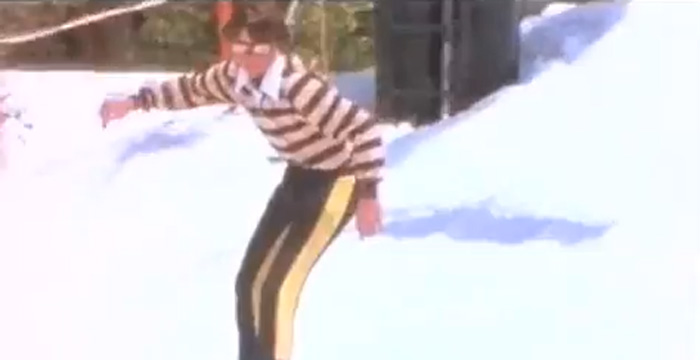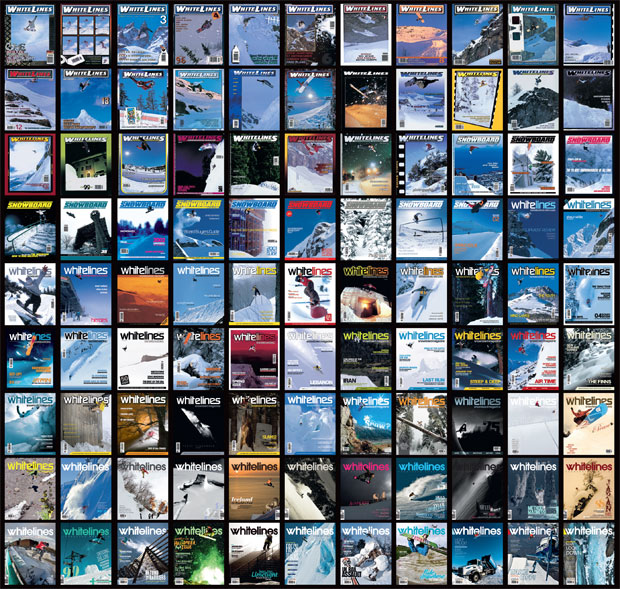Photo: Bud Fawcett
The mid to late 1980s were an interesting time for snowboarding. While the competition scene was ticking along nicely, newly emerging film-makers were starting to showcase a different breed of riders. Three of the biggest films of the era, Riders on the Storm, Snowboarders in Exile and Critical Condition perfectly showcased this developing scene, in which a crew of anti-establishment, punk-like snowboarders focused not on results but on exploring the backcountry – going bigger and spinning harder off hand-built kickers and natural terrain.
“It’s easy to see why he stood out – almost every item of clothing he wore had been dyed neon”
A few riders defined the era – Steve Graham, Dave Seone and Chris Roach to name just three – but it was the energy of Damian Sanders that really captured the spirit of the time. It’s easy to see why he stood out so much: almost every item of clothing he wore had been dyed neon. And if that wasn’t enough, to top everything off he rode in hard boots. Even back then, he was alone in thinking it was a good idea. “I can go bigger,” he reasoned in a Transworld interview at the time.
What is remarkable is that his actions backed up this claim. While other riders were pushing their own boundaries, Damian would hike higher, go faster, get inverted, and bulldoze his way through any landing with his ankle-strengthened might. His whole character was – in a word – arresting.
Riding his brother Chris Sander’s Avalanche snowboards around the resorts of Lake Tahoe, it hadn’t taken long for the actions of this blonde skate-punk and his vagabond mates to attract the attention of emerging surf brand Ocean Pacific. O.P’s range of bright one-piece suits jarred with the Bones-Brigade image that Damian and his contemporaries preferred, but there was no mistaking the amount of publicity such eye-catching garments brought. Before long, the Californian riders embraced the colour scheme to the point of no return. In 1986, hot pink quite literally became the new black.
What stopped any potential ridicule was of course their riding standard. Critical Condition showed the undoubted talents of big mountain riders such as Tom Burt, Jim Zellers and Dave Hatchet, and there was enough freestyle action from Roach, Seone and Noah Salasnek to keep the jibbers happy. But it was Sanders who brought the two together, busting enormous freestyle spins and inverts in the Tahoe backcountry, and proving conclusively that you could pull off stylish grabs and spins while launching off enormous cliffs. Snowboarders in Exile showed him railsliding trees and backflipping off solid 30-foot drops – all completely new moves in 1989.
Ultimately, however, these early movies were a cultural cul-de-sac. Terje Haakonsen burst on the scene in 1991 (in soft boots!) and started to push freestyle riding in a slick, technical and stylish direction, while the cliff-mongering of Shaun Farmer and his contemporaries meant freeride board lengths were going in a completely opposite direction. Until Johan Olofsson came along in 1996 and tied the two worlds back together, freestyle and freeriding looked to be virtually different sports, with different ideals. By then however, snowboarding had become a much altered place, and anything remotely connected to the skiing fraternity was virtually ostracised. Sanders’ outrageous clothing, hairstyle, neon headbands and of course – his hard boots – were history. Did he mind? Well, by then he was married to a Playboy Playmate named Brandy and had moved to LA to go partying with Guns N Roses and Motley Crue. Fitting really, for a man whose persona was certainly more Billy Idol than the Sex Pistols.
Click here to see Damien’s incredible talent for yourself.
What Happened Next:
Contemporaries Mike and Dave Hatchet went from being riders in their own films to solely directing them, just as a new breed of Euro freestylers came onto the scene and blew everyone out of the water. Fall Line morphed into Standard Films and the Totally Board (TB) series came into being. Damian’s riding partners Steve Graham and Dave Seone became film-makers, with Seone behind both the seminal Subjekt: Haakonsen and The White Album.
Damian immersed himself in the LA party scene, getting his teeth filed into vampire fangs and becoming a goth, fetish DJ. In the mid 90s Damian went into partnership with Jon Huntington, a club promoter on the LA scene, and the two men now head up Spiritworld Productions, putting on fetish nights in California and Nevada. They own several clubs in the states, including Rubber in the heart of Las Vegas’s Strip. “Rubber has a certain style,” said Damian in a recent interview. “The stages, the dancers, the music; it all screams of sex.”






